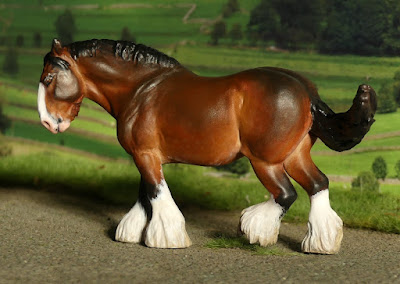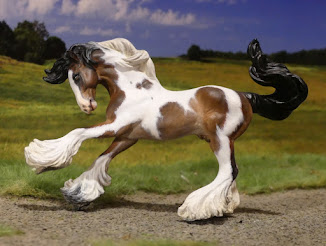It's a little known fact that my infamous body box isn't just a simple cardboard box, but has an extension out the back. Hidden in the space behind the tv stand are all the resin bodies I've accumulated over time - some rescues, which I got cheaply broken or battered; some raw castings picked up at live shows over a decade ago; some over-ambitiously BIG horses I've put to one side because brush-painting larger scales is scary. They'd become very much an out-of-sight-out-of-mind aspect of my collection of bodies, Stablemates were smaller and easier and that's where I felt comfortable so that's where I tended to stay. This year I've been determinedly broadening my painting horizons little by little, with Mini Whinnies and CollectAs sprinkled between the SMs, and the other day I decided to go one further and have a careful rummage through the dusty resin graveyard and pick out something different.
What I found was a horse I didn't know I'd got. I don't have a clue where I bought her, other than it might've been the sales table at a live show because she'd got her price and someone's initials scribbled in pen under her belly!
She also had a moulding flaw, the poured liquid resin not having reached one of her feet, so she had a hollow hoof tip but no heel or sold, and a big chunk of her feathering lost. I suspect that's why she was cheap enough for me to have come home with her in the first place, though I do wish I could remember this happening!
It took me some investigation after painting to even find out what she was, the resin not being instantly familiar, and I had to look through every shire, clydesdale, non-specified draft, and finally the 'other' section on Equineresinsdirectory before finally finding out her details : Horsing Around's Lissy, by James Richmond, an edition of 50 back in 2010.
Here she is, all finished up!
I've named her Harecroft Grace, and done her as a bay with plenty of white, but not too-white white - I imagine her as a relaxed broodmare taking it easy in her field, fidgeting to shift position mid nap on a sunny day, rather than all scrubbed and polished and chalked for the show ring, perhaps she's even retired, her tail's been allowed to grow long as a fly whisk, not trimmed for correct turnout.
The weather and low sun trouble this time of year made it tricky to get any photos of her at all, so these were all taken indoors with fake light or raking awkward daylight from the window above the front door - I had several goes on different days, which gave a huge amount of variety in the lighting and how it makes her look, but none of it was helpful for especially good photography! The third picture is perhaps the best of the three, though I do like the blue sky in the first shot, and still haven't decided which I'll use for my website or to show her.
The raised hind leg is where I replaced her missing hoof and heel, I did that before tracking down any pictures of the resin which I could have copied from, but now I've seen them, I find my guess isn't far different from how she was originally sculpted.
I really like how she turned out, one of my favourite customs of this year, but I love her profile most of all - that big roman nose which looks all the more noticeable under the highlighting wide white blaze!
The second resin is going to be much more familiar to a lot of collectors - he's Breyer's christmas ornament version of the Traditional vanner mould. He came to me in a box of normal plastic SM bodies on Ebay - whoever had them before had taken off his unicorn horn with a saw or possibly a dremel, but also cut a chunk out of his stifle in the process, then given up and sold him with the rest.
With a bit more filing, some carefully milliputting to patch up his accidental wound, and a lot of scraping to get rid of the coating of glittery glue all over his mane, tail, and legs (part of Breyer's persistent insistence that all unicorns must be sparkly), he was ready to paint.
And let's be honest, there was only one colour this lad was ever going to end up...
He really suits this colouring, I think, I might've aimed for more bay and less white but this is just the point where he started to look good so I stopped before I spoilt the paintjob. On this one I did the white first, because I had a nearly-dry pot of white paint to use up, and it goes on fine as a base coat if it's getting sticky and solid, but doesn't co-operate if trying to add markings over the colour. I just went along at the end and used a little bit of my fresh new pot of white for feathering the edges gently into each other so he looks fluffy.
Like with Grace, I gave him faintly dirty feathering, and also a hint of blonde in his mane, just cos he doesn't need to look show-ring-shampoo-white. I've named him Harecroft Rapscallion, though with a mouthful of a name like that, I bet it'd soon get shortened to 'Scally' round the yard!
I'm not sure if there's any difference between this resin edition of the mould, and the plastic Stablemate version, one day I'll have to compare them in hand but I think they're identical and you'd only know this one was resin by the weight, they did a good job of translating the mould into plastic without losing the crispness of detail for the hairy bits!


























































